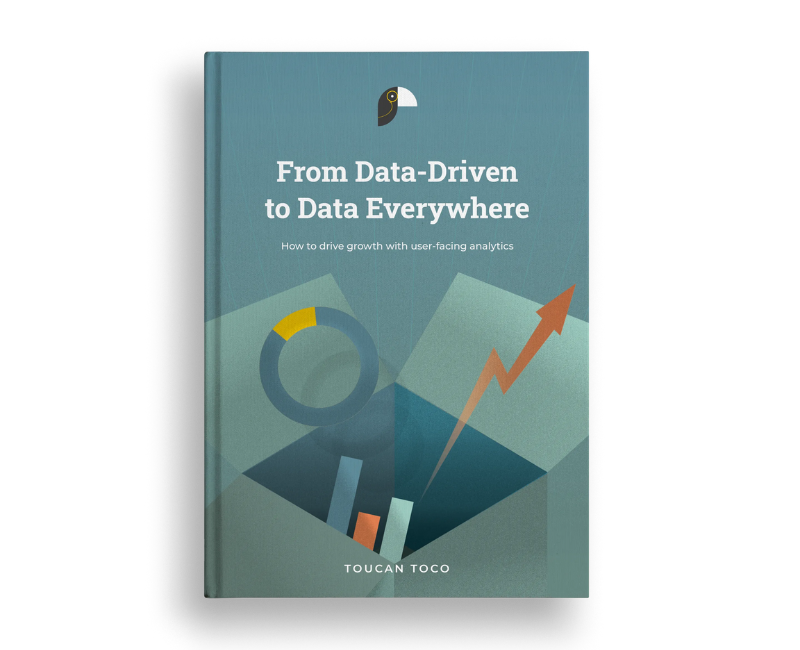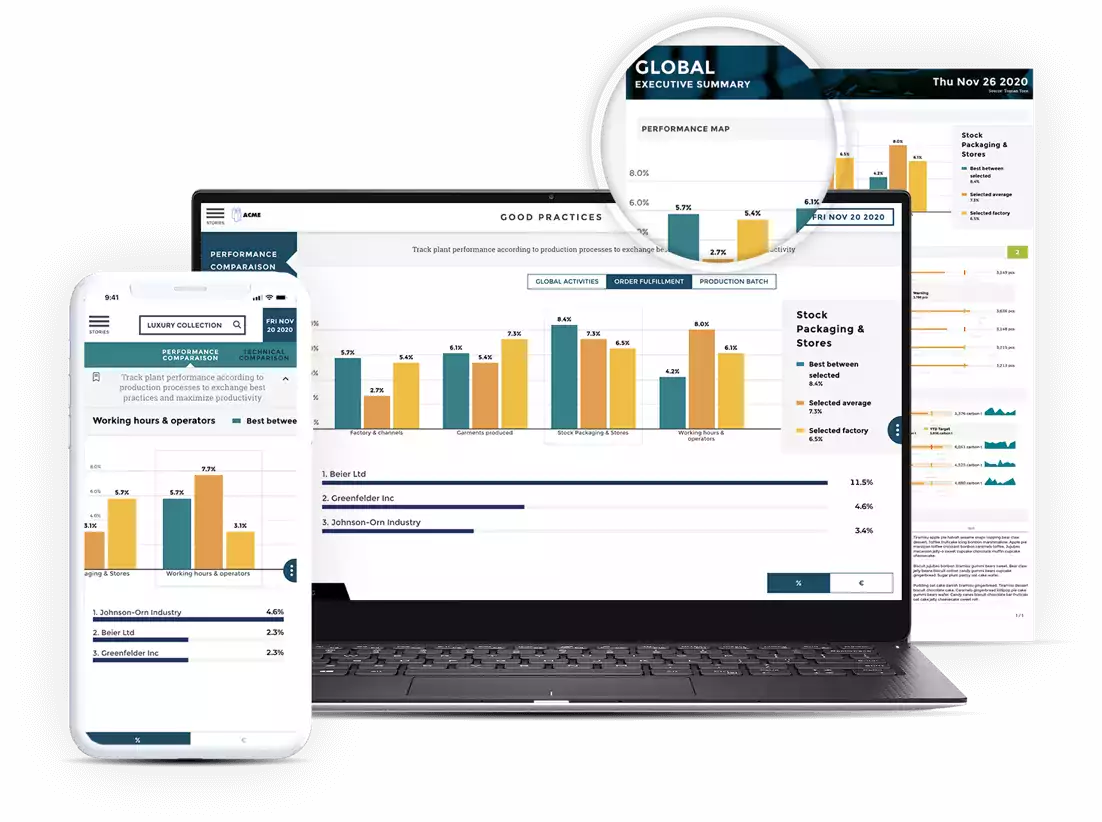
While companies have always relied on analytics internally to make decisions, they recently discovered the potential of data analytics for their customers.
The reason is simple: people are demanding the integration of analytics features into the technology solutions they use.
The popularity of customer-facing analytics stems from this need to deliver real-time insights and create a better customer experience.
What is it exactly, and what are its main benefits? What are the key features of effective customer-facing analytics? Should you build or buy? Let’s take a look at customer-facing analytics.
What is the difference between traditional BI and customer-facing analytics?
While traditional BI and customer-facing analytics could seem similar, there are in fact core differences between the two.
Unlike traditional business intelligence that focuses on internal data for strategic company decisions, customer-facing analytics is external and aims at providing users with actionable, real-time information.
Think about it: in an ocean of data, traditional BI could be compared to a very experienced sailor, helping companies to navigate a very competitive environment by giving them information about the wind speeds, the weather changes...
He gives clear directions as to where the crew should head towards.
Now, customer-facing analytics would be a tour guide on a sightseeing boat. He’s showing the passengers - aka the customers - the most interesting parts of the ocean - the data.
In other words, it provides end users with valuable insights of a product/service, directly affecting the way they see and interact with your company.
But it’s not the only difference: as traditional business intelligence generally only uses data that has been collected and stored in databases and data warehouses, customer-facing analytics can also leverage real-time data streams from customer interactions.
It is designed to deliver end-users with actionable information. It can take multiple forms: interactive dashboards, web applications, mobile applications…
Spotify: an example of successful customer-facing analytics
Still don’t really understand the purpose of customer-facing analytics? Let’s take a real-life example to illustrate what it is. If you have Spotify, you’re certainly looking forward to your annual Wrapped - a review of your top songs, artists and genres of the year, total minutes listened… This annual compilation of data made by Spotify is nothing less than one of the most successful marketing campaigns in the 21st century. By giving users access to their data, Spotify creates each year a social media frenzy.
What explains such a success is simple: not only does it engage users of the platform, but it also relies on FOMO. People who do not use Spotify see others sharing music trends without being able to participate. It’s a smart way to get them to download the app so they can share in this experience!
This example perfectly highlights the power of customer-facing analytics when it comes to building a brand’s success.
The importance of customer-facing analytics for your business
Why is customer-facing analytics so strategic for companies? Customers rely more and more on data to make decisions and purchase products or services. This shift in data use brings many benefits to customers:
- Increase customer engagement: Creating personalized and customized experiences is a must do in today’s business environment to ensure customer satisfaction. When companies invest in improving digital customer engagement, they see their average revenue increase drastically. Giving users customer-facing embedded analytics, such as tailored recommendations, keeps them engaged. They will likely want to explore data stories and learn more about them.
- Enhanced decision making for customers: Showing data to customers enables them to make informed decisions based on analytics (financial dashboards, product comparisons…). It is particularly accurate for B2B companies: if you are able to demonstrate to your customers how your service/product is helping them grow their business, they will be more likely to buy it.
- Build a stronger relationship: Customers crave transparency and trust, which have become a critical part of a company’s overall success.This entails providing your customers with visibility to see and verify your actions at all times. Sharing data is a practical way to show you don’t have any hidden agenda and you are perfectly transparent with them. Not only does it allow you to attract new customers, but it also leads to customer retention and loyalty.
- Competitive advantage: Customer-facing analytics is a good way to stand out from your competitors or address any competitive gaps a challenging feat in today’s crowded market. If done correctly, it can boost your reputation and help you close more sales.
- Create a new offer with “premium analytics” option: Customer-facing analytics can also be an opportunity to develop a new service with premium data, just like Strava does. The popular exercise tracking app offers a premium subscription plan with a package of unique features, which includes insights like training log, heart rate, pace zone, routes…
- B2B companies like Atlassian have also started leveraging the power of analytics to create new offers. Atlassian Analytics offers simple and flexible ways to visualize data across Atlassian products and other data sources, giving you holistic insights into how work gets done across teams.
6 key features of effective customer-facing analytics
Adopting customer-facing analytics within your company is easier said than done. It requires a tool that can both leverage data insights effectively and meet customer expectations regarding data visibility (which is not the case of traditional BI tools, usually built for end-users). This is where embedded customer-facing analytics come in, with specific features:
- Data source connectors: Users should easily connect to various data sources and access the information they need. No matter where the data comes from, they should be able to get it and gather insights in a few clicks only.
- Easily embed with white labeling: A good customer-facing analytics solution should seamlessly integrate with your current business processes and customer interfaces (CRM , ERP application, SaaS…). Our recommendation: choose a tool specifically designed for embedding,offering multiple layouts options , with complete dashboards, individual charts and PDF reporting. Also, it should be responsive.
- Data visualization tool: In order to make data appealing for users, the interface should be visually engaging. It has to provide valuable insights without overwhelming the customer. Remember: your goal is to make it easy for users to extract insights. Offering a library of graphs and charts encourages data exploration.
- Collaboration and sharing: Information should be easy to share. This is the essence of customer-facing analytics. Ideally, the tool allows users to team up on projects, have real-time discussions and share reports and dashboards, and even export data for deeper analysis.
- Data governance: Investing in a highly-secured customer-facing analytics tool is crucial. It must be easy to incorporate into your existing security policy, allow you to adjust user roles, set permissions to access reports, support robust authentication methods, and secure other user data from multi-tenant environments.
- Customization: Extensive customization options enable users to adapt their analytics experiences to meet their needs. Each customer should be able to focus on the data which is relevant to their business and personalize dashboards or graphs to make the tool their own.
Customer-facing analytics: should you build or buy?
When it comes to delivering customer-facing analytics, should you build or buy an analytics solution? Although most companies choose to buy a specific tool to integrate with their current ecosystem, it is worth considering both options before you make your decision.
|
Build |
Buy |
|
|
Pros |
|
|
|
Cons |
|
|
When facing the challenges of building an analytics solution, most companies buy an existing tool to save time and be able to focus on their business core competency. However, in order to avoid being limited by the solution, it’s crucial to select the tool carefully and take a closer look at the existing features (does it integrate with my software, can I connect multiple data sources ?...).
Toucan was designed specifically to offer a customizable, embedded analytics platform that allows technology providers to offer their customers user-facing analytics without needing to divert internal resources. Thanks to Toucan’s seamless, white-label customizability, companies are able to integrate it into their existing application in a few clicks. Book a demo to learn more about Toucan’s magic.





